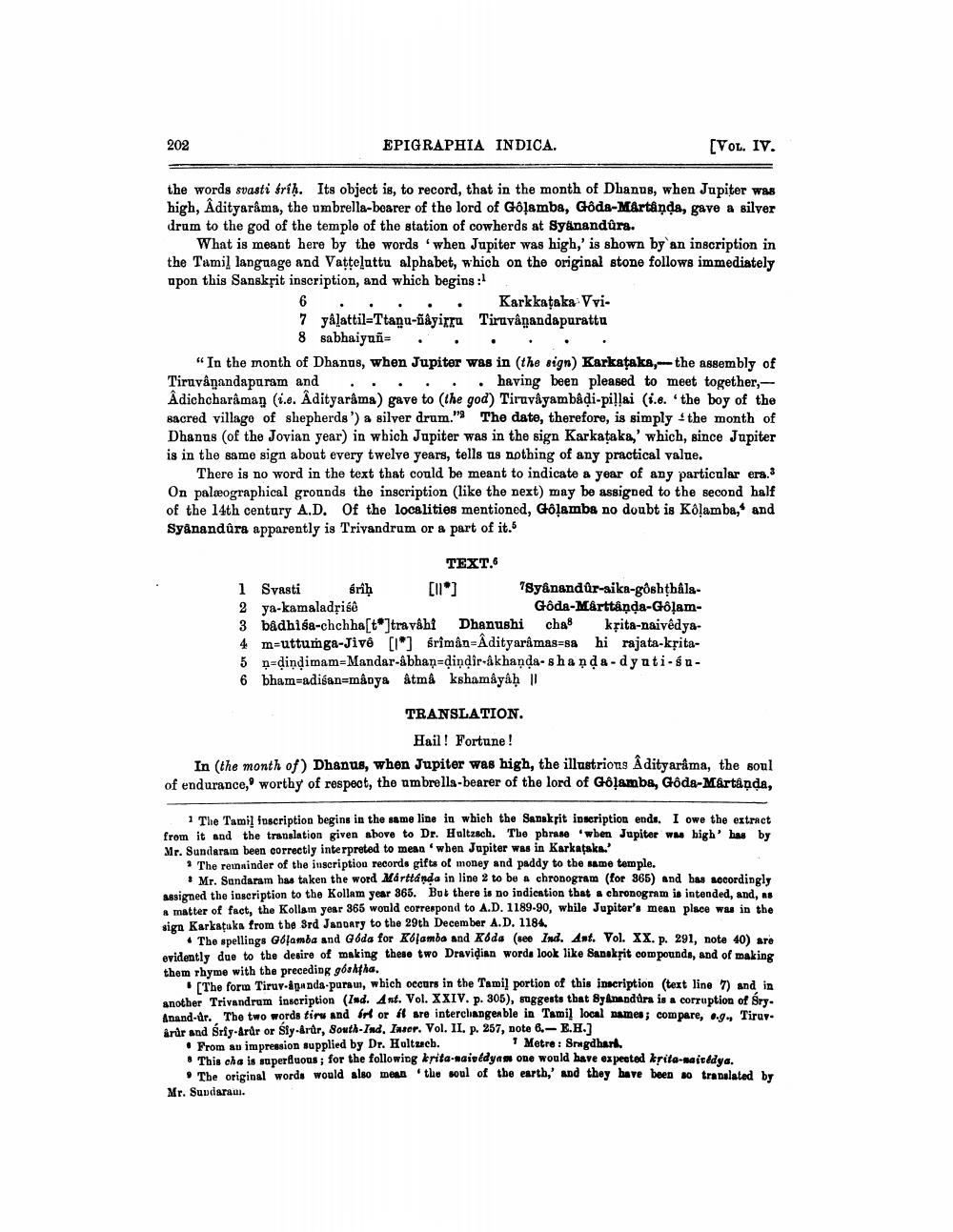________________
202
EPIGRAPHIA INDICA.
(VOL. IV.
the words svasti frih. Its object is, to record, that in the month of Dhanus, when Jupiter was high, Adityarâma, the umbrella-bearer of the lord of Goļamba, Gôda-Martånda, gave a silver drum to the god of the temple of the station of cowherds at Syanandúra.
What is meant here by the words when Jupiter was high,' is shown by an inscription in the Tamil language and Vatteluttu alphabet, which on the original stone follows immediately upon this Sanskrit inscription, and which begins :
6 . . . . . Karkkataka Vvi7 yaļattil-Ttanu-ñáyirru Tiruvanandapurattu
8 sabhaiynñ= . . . . . "In the month of Dhanus, when Jupiter was in the sign) Karkataka,--the assembly of Tiruvanandapuram and .. . . . . having been pleased to meet together, Âdichcharaman (i.e. Âdityaráma) gave to the god) Tiruvayambåļi-pillai (i.e. the boy of the sacred village of shepherds') a silver drum." The date, therefore, is simply the month of Dhanus (of the Jovian year) in which Jupiter was in the sign Karkataka,' which, since Jupiter is in the same sign about every twelve years, tells us nothing of any practical value.
There is no word in the text that could be meant to indicate a year of any particular era. On palæographical grounds the inscription (like the next) may be assigned to the second half of the 14th century A.D. Of the localities mentioned, Golamba no doubt is Kolamba," and Syanandûra apparently is Trivandrum or a part of it.
TEXT. 1 Svasti srth [11*] 18yanandur-aika-gôshthala2 ya-kamaladpise
Gôda-Mårttånda-Gálam3 bâdhisa-chchha[t*]travahi Dhanushi cha krita-naivedya4 m-uttumga-Jive [1] śriman Adityarâ mas=sa hi rajata-krita5 n dindimam-Mandar-abhan-dindir-akhanda-s handa-d yuti-su6 bham-adisan=mânya åtmå kshamayaḥ 11
TRANSLATION.
Hail! Fortune! In the month of Dhanus, when Jupiter was high, the illustrious Adityaráma, the soul of endurance, worthy of respect, the umbrella-bearer of the lord of Golambe, Goda-Mártånda,
The Tamil inscription begins in the same line in which the Sanskrit inscription ends. I owe the extract from it and the translation given above to Dr. Haltzsch. The phrase "wben Jupiter was high' has by Mr. Sundarain been correctly interpreted to mean when Jupiter was in Karkataka.
* The reininder of the inscription records gifts of money and paddy to the same temple.
* Mr. Sandaram has taken the word Marttánda in line 2 to be a chronogram (for 865) and has accordingly Assigned the inscription to the Kollam year 365. But there is no indication that a chronogram is intended. and. A matter of fact, the Kollam year 365 would correspond to A.D. 1189-90, while Jupiter's mean place was in the sign Karkataka from the 3rd Janoary to the 29th December A.D. 1184
The spellings Gólamba and Gbda for Kolamba and Kóda (see Ind. Ant. Vol. XX. p. 291, note 40) are evidently due to the desire of making these two Dravidian words look like Sanskrit compounds, and of making them rhyme with the preceding goshtha.
The form Tiruvapanda puram, which occurs in the Tamil portion of this inscription (text line 7) and in anotber Trivandrum inscription (Ind. Ant. Vol. XXIV. p. 305), suggests that Bynandúra is a corruption of Sry. Anand-år. The two words tirs and fri or ff are interchangeable in Tamil local names; compare, ..g., Tirup. irúr and Sriy-Arur or siy-Arar, South-Ind. Inser. Vol. II. p. 257, note 8.-E.H.] • From an impression supplied by Dr. Holtuch.
Metre: Srugdhari. • This cha is superfluous; for the following krita-waivedyn one would have expected krita-nairedya.
• The original words would also mean the soul of the earth,' and they have been so translated by Mr. Sundaraui.




